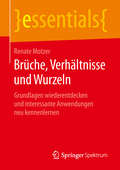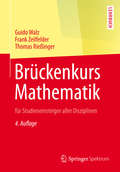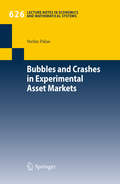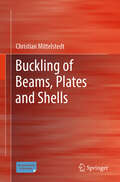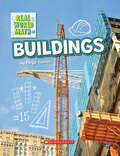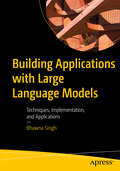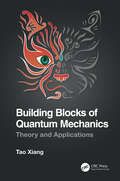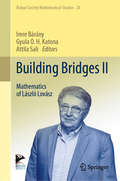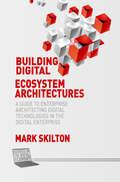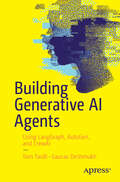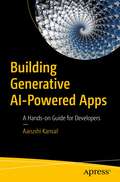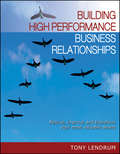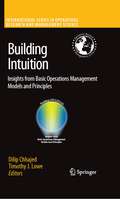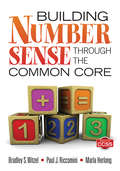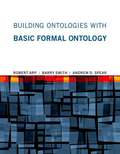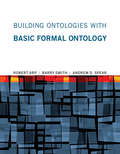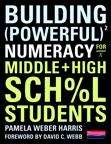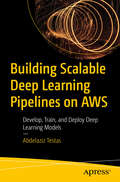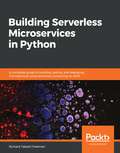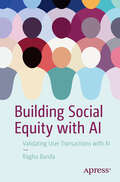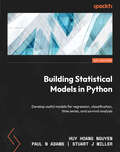- Table View
- List View
Brüche, Verhältnisse und Wurzeln: Grundlagen wiederentdecken und interessante Anwendungen neu kennenlernen (essentials)
by Renate MotzerRenate Motzer führt in die Welt der Brüche ein und bringt sie in Verbindung mit Dezimalzahlen. Sie zeigt anschaulich, dass Brüche als Anteile eines Ganzen verstanden werden können, aber auch als Verhältnisse von zwei Größen. Die Autorin zeigt verständlich auf, warum Wurzeln nicht exakt durch Brüche angegeben werden können, wie man gute Näherungen findet und warum eine ungewöhnliche Bruchaddition zu paradoxen Ergebnissen führen kann. Weiterhin erläutert sie praxisnah die Anwendung von Brüchen beim Prozentrechnen und in der Wahrscheinlichkeitsrechnung und geht schließlich auf verschiedene Möglichkeiten ein, Mittelwerte zu bilden.
Brückenkurs Mathematik: für Studieneinsteiger aller Disziplinen
by Guido Walz Frank Zeilfelder Thomas RießingerDieses Buch erspart Ihnen die Einstiegsprobleme in die Mathematik, indem es Ihnen auf unterhaltsame Weise eine Brücke baut, die Sie sanft über alle Untiefen hinweg ins Innere der Hochschulmathematik hineingeleitet. Die Brücke beginnt auf der einen Seite beim einfachen Zahlenrechnen, wie es Ihnen vermutlich in der Mittelstufe schon begegnet ist, und führt Sie hinüber bis zu den Grundlagen von Linearer Algebra, Differenzialrechnung und Wahrscheinlichkeitsrechnung, die die Hauptinhalte Ihrer ersten Semester darstellen werden. Diesen Inhalten werden Sie dort immer gegenüber stehen, und bei deren Behandlung können Sie dann beruhigt sagen: "Kenn' ich schon!" Zu jedem Kapitel finden sich Übungsaufgaben, mit deren Hilfe die vermittelten Inhalte eingeübt und vertieft werden können. Neu in die 4. Auflage aufgenommen ist ein Kapitel zur deskriptiven Statistik.
Bubbles and Contagion in Financial Markets, Volume 2: Models and Mathematics
by Eva R. PorrasThis book focuses on extending the models and theories (from a mathematical/statistical point of view) which were introduced in the first volume to a more technical level. Where volume I provided an introduction to the mathematics of bubbles and contagion, volume II digs far more deeply and widely into the modeling aspects.
Bubbles and Crashes in Experimental Asset Markets (Lecture Notes in Economics and Mathematical Systems #626)
by Stefan PalanThis book describes a laboratory experiment designed to test the causes and properties of bubbles in financial markets and explores the question whether it is possible to design markets which avoid such bubbles and crashes. In the experiment, subjects were given the opportunity to trade in a stock market modeled after the seminal work of Smith et al. (1988). To account for the increasing importance of online betting sites, subjects were also allowed to trade in a digital option market. The outcomes shed new light on how subjects form and update their expectations, placing special emphasis on the bounded rationality of investors. Various analytical bubble measures found in the literature are collected, calculated, classified and presented for the first time. The very interesting new bubble measures "Dispersion Ratio", "Overpriced Transactions" and "Underpriced Transactions" are developed, making the book an important step towards the research goal of preventing bubbles and crashes in financial markets.
Buckle Down: Louisiana Mathematics Level 4
by The Editors at the Buckle Down PublishingLouisiana Mathematics Level 4 test prep
Buckling of Beams, Plates and Shells
by Christian MittelstedtThis book contains an introduction to the fundamental principles of the theory of stability of elastic bodies and structures. Beginning with very basic explanations of stability problems, this book starts with the treatment of systems of rigid beams, before beams under normal force and bending as well as the classical field of beam buckling are treated. For the case of beam buckling, an energetic consideration then follows, which forms the basis for a series of approximation methods. In addition to beam buckling, the stability cases of lateral-torsional buckling and lateral buckling are also of fundamental importance, to each of which a separate chapter is dedicated. This is followed by a discussion of plate buckling, and the book concludes with an introduction to shell buckling. This book is aimed at students at technical colleges and universities, as well as engineers in practice and researchers in the engineering sciences.
Building (Real World Math)
by Paige TowlerGrab your hard hat and get ready to use math to learn all about buildings!1 skyscraper … 2 houses … 3 castles—the world is full of buildings! Architects use math every day to design buildings. Join a real architect on an amazing adventure to recognize SHAPES, discover PATTERNS, COMPARE skyscraper sizes, and more. Then test your math skills with special You Can Do It challenges.This brand-new series demonstrates how math skills can be applied to high-interest topics and careers in Coding, Building, Tracking Animals, and Space Exploration. The K-2 math concepts include counting 1-100 with basic addition and subtraction, using the power of 10, measuring, and simple geometry. Real world scientists, architects, programmers, and mathematicians model hands-on, from-the-field experiences in a way that will make children excited to use and expand their math skills!
Building Applications with Large Language Models: Techniques, Implementation, and Applications
by Bhawna SinghThis book delves into a broad spectrum of topics, covering the foundational aspects of Large Language Models (LLMs) such as PaLM, LLaMA, BERT, and GPT, among others. The book takes you through the complexities involved in creating and deploying applications based on LLMs, providing you with an in-depth understanding of the model architecture. You will explore techniques such as fine-tuning, prompt engineering, and retrieval augmented generation (RAG). The book also addresses different ways to evaluate LLM outputs and discusses the benefits and limitations of large models. The book focuses on the tools, techniques, and methods essential for developing Large Language Models. It includes hands-on examples and tips to guide you in building applications using the latest technology in Natural Language Processing (NLP). It presents a roadmap to assist you in navigating challenges related to constructing and deploying LLM-based applications. By the end of the book, you will understand LLMs and build applications with use cases that align with emerging business needs and address various problems in the realm of language processing. What You Will Learn Be able to answer the question: What are Large Language Models? Understand techniques such as prompt engineering, fine-tuning, RAG, and vector databases Know the best practices for effective implementation Know the metrics and frameworks essential for evaluating the performance of Large Language Models Who This Book Is For An essential resource for AI-ML developers and enthusiasts eager to acquire practical, hands-on experience in this domain; also applies to individuals seeking a technical understanding of Large Language Models (LLMs) and those aiming to build applications using LLMs
Building Blocks of Quantum Mechanics: Theory and Applications
by Tao XiangThis textbook provides a concise yet comprehensive introduction to the principles, concepts, and methods of quantum mechanics. It covers the basic building blocks of quantum mechanics theory and applications, illuminated throughout by physical insights and examples of quantum mechanics, such as the one-dimensional eigen-problem, the harmonic oscillator, the Aharonov-Bohm effect, Landau levels, the hydrogen atom, the Landau-Zener transition and the Berry phase. This self-contained textbook is suitable for junior and senior undergraduate students, in addition to advanced students who have studied general physics (including classical mechanics, electromagnetics, and atomic physics), calculus, and linear algebra.Key features: Presents an accessible and concise treatment of quantum mechanics Contains a wealth of case studies and examples to illustrate concepts Based off the author's established course and lecture notes
Building Bridges II: Mathematics of László Lovász (Bolyai Society Mathematical Studies #28)
by Imre Bárány Gyula O. H. Katona Attila SaliThis volume collects together research and survey papers written by invited speakers of the conference celebrating the 70th birthday of László Lovász.The topics covered include classical subjects such as extremal graph theory, coding theory, design theory, applications of linear algebra and combinatorial optimization, as well as recent trends such as extensions of graph limits, online or statistical versions of classical combinatorial problems, and new methods of derandomization.László Lovász is one of the pioneers in the interplay between discrete and continuous mathematics, and is a master at establishing unexpected connections, “building bridges” between seemingly distant fields. His invariably elegant and powerful ideas have produced new subfields in many areas, and his outstanding scientific work has defined and shaped many research directions in the last 50 years. The 14 contributions presented in this volume, all of which are connected to László Lovász's areas of research, offer an excellent overview of the state of the art of combinatorics and related topics and will be of interest to experienced specialists as well as young researchers.
Building Dialogue POMDPs from Expert Dialogues: An end-to-end approach (SpringerBriefs in Speech Technology)
by Hamidreza Chinaei Brahim Chaib-DraaThis book discusses the Partially Observable Markov Decision Process (POMDP) framework applied in dialogue systems. It presents POMDP as a formal framework to represent uncertainty explicitly while supporting automated policy solving. The authors propose and implement an end-to-end learning approach for dialogue POMDP model components. Starting from scratch, they present the state, the transition model, the observation model and then finally the reward model from unannotated and noisy dialogues. These altogether form a significant set of contributions that can potentially inspire substantial further work. This concise manuscript is written in a simple language, full of illustrative examples, figures, and tables.
Building Digital Ecosystem Architectures: A Guide to Enterprise Architecting Digital Technologies in the Digital Enterprise (Business in the Digital Economy)
by Mark SkiltonThe design of digital solutions has become a pressing concern for practitioners faced with a plethora of technology impacting their business. From cloud computing to social networks, mobile computing and big data, to the emerging of Internet of things, all of which are changing how enterprise products, services, rooms and buildings are connected to the wider ecosystem of networks and services. This book defines digital ecosystems with examples from real industry cases and explores how enterprise architecture is evolving to enable physical and virtual, social, and material object collaboration and experience. The key topics covered include:Concepts of digitizationTypes of technological ecosystemsArchitecting digital workspaces Principles of architecture design Examples architecting digital business models Examples of digital design patterns Methods of monetizationConclusions
Building Generative AI Agents: Using LangGraph, AutoGen, and CrewAI
by Tom Taulli Gaurav DeshmukhThe dawn of AI agents is upon us. Tech visionaries like Bill Gates, Andrew Ng, and Vinod Khosla have highlighted the monumental potential of this powerful technology. This book will provide the knowledge and tools necessary to build generative AI agents using the most popular frameworks, such as AutoGen, LangChain, LangGraph, CrewAI, and Haystack. Recent breakthroughs in large language models have opened up unprecedented possibilities. After years of gradual progress in machine learning and deep learning, we are now witnessing novel approaches capable of understanding, reasoning, and generating content in ways that promise to revolutionize nearly every industry. This platform shift is as significant as the advent of mainframes, PCs, cloud computing, mobile technology, and social media. It’s why the world’s largest technology companies – like Microsoft, Apple, Google, and Meta – are making enormous investments in this category. While chatbots like ChatGPT, Claude, and Gemini have demonstrated remarkable potential, the years ahead will see the rise of generative AI agents capable of executing complex tasks on behalf of users. These agents already exhibit capabilities such as running test suites, searching the web for documentation, writing software, answering questions based on vast organized information, and performing intricate web-based tasks across multiple domains. They can autonomously investigate cybersecurity incidents and address complex customer support needs. By integrating skills, knowledge bases, planning frameworks, memory, and feedback loops, these systems can handle many tasks and improve over time. Building Generative AI Agents serves as a high-quality guide for developers to understand when and where AI agents can be useful, their advantages and disadvantages, and practical advice on designing, building, deploying, and monitoring them. What You Will Learn The foundational concepts, capabilities, and potential of AI agents. Recent innovations in large language models that have enabled the development of AI agents. How to build AI agents for launching a product, creating a financial plan, handling customer service, and using Retrieval Augmented Generation (RAG). Essential frameworks for building generative AI agents, including AutoGen, LangChain, LangGraph, CrewAI, and Haystack. Step-by-step guidance on designing, building, and deploying AI agents. Insights into the future of AI agents and their potential impact on various industries. Who This Book Is For Experienced software developers
Building Generative AI-Powered Apps: A Hands-on Guide for Developers
by Aarushi KansalGenerative AI has gone beyond the responsibility of researchers and data scientists and is being used by production engineers. However, there is a lot of confusion where to get started when building an end-to-end app with generative AI. This book consolidates core models, frameworks, and tools into a single source of knowledge. By providing hands-on examples, the book takes you through the generative AI ecosystem to build applications for production.The book starts with a brief and accessible introduction to transformer models before delving into some of the most popular large language models and diffusions models (image generation). These models are the foundations of both AI and your potential new apps. You will then go through various tools available to work with these models, starting with Langchain, a framework to develop foundational models, which is the next building block you should grasp after understanding generative AI models. The next chapters cover databases, caching, monitoring, etc., which are the topics necessary to build larger-scale applications. Real-world examples using these models and tools are included.By the end of this book, you should be able to build end-to-end apps that are powered by generative AI. You also should be able to apply the tools and techniques taught in this book to your use cases and business.What You Will LearnWhat is Generative AI?What is ChatGPT and GPT4?What are language models and diffusions models?How do we deploy LangChain and HuggingFace?Who This Book Is ForSoftware engineers with a few years of experience building applications in any language or infrastructure
Building High Performance Business Relationships: Rescue, improve and transform your most valuable assets
by Tony LendrumA practical guide for building and maintaining high performance business relationships Every business sinks or swims on the quality of its relationships and alliances, whether they are between management and staff, departments, subsidiaries, partners, suppliers, or customers. It's no wonder then that building and maintaining high performance relationships has emerged as one of the hottest topics in today's hypercompetitive, global business environment. This indispensable guide will help you to understand what high performance relationships are and how they work. Written by a distinguished pioneer in the field, it explains what a high performance business culture populated by a fully engaged workforce looks like. It describes simple, proven strategies and techniques for implementing and sustaining high performance relationships, both internally, within your organizations, and externally. And, it details the many benefits that await business organizations of any size that place greater emphasis on relationship performance management. Offers simple and effective methods for building successful business and organizational relationships Concise and easy to read, this book provides a common language and practice for high performance relationship management and critical change management Arms you with an array of tested-in-the-trenches tools for building robust and sustainable high performance business relationships
Building Intuition: Insights from Basic Operations Management Models and Principles (International Series in Operations Research & Management Science #115)
by Timothy J. Lowe Dilip ChhajedThis is the first book in the field that uses the power of the basic models and principles to provide students and managers with an "intuitive understanding" of operations management. The book touches on nine fundamental models and principles, and outlines the key insights behind each one. Some of the very biggest names in the Management Science field have developed and carefully written these chapters on the field's basic models.
Building Number Sense Through the Common Core
by Bradley S. Witzel Paul J. Riccomini Marla L. HerlongBuild a lasting foundation for math proficiency right from the start The "math" is on the wall: unless our youngest mathematicians have a solid understanding of number sense, they have little hope of mastering the higher math that lies ahead. This essential resource helps you identify where K-3 students are likely to struggle, and then intervene with smart, targeted instruction. The authors provide: Teaching strategies that build number sense skills, including quantity and cardinality, fact fluency, and more Adaptations for students with specific needs, based on an RTI approach Guidance on measuring number sense through assessments User-friendly charts, tables, and sample math problems
Building Ontologies with Basic Formal Ontology
by Robert Arp Barry Smith Andrew D. SpearIn the era of "big data," science is increasingly information driven, and the potential for computers to store, manage, and integrate massive amounts of data has given rise to such new disciplinary fields as biomedical informatics. Applied ontology offers a strategy for the organization of scientific information in computer-tractable form, drawing on concepts not only from computer and information science but also from linguistics, logic, and philosophy. This book provides an introduction to the field of applied ontology that is of particular relevance to biomedicine, covering theoretical components of ontologies, best practices for ontology design, and examples of biomedical ontologies in use.After defining an ontology as a representation of the types of entities in a given domain, the book distinguishes between different kinds of ontologies and taxonomies, and shows how applied ontology draws on more traditional ideas from metaphysics. It presents the core features of the Basic Formal Ontology (BFO), now used by over one hundred ontology projects around the world, and offers examples of domain ontologies that utilize BFO. The book also describes Web Ontology Language (OWL), a common framework for Semantic Web technologies. Throughout, the book provides concrete recommendations for the design and construction of domain ontologies.
Building Ontologies with Basic Formal Ontology (The\mit Press Ser.)
by Robert Arp Barry Smith Andrew D. SpearAn introduction to the field of applied ontology with examples derived particularly from biomedicine, covering theoretical components, design practices, and practical applications.In the era of “big data,” science is increasingly information driven, and the potential for computers to store, manage, and integrate massive amounts of data has given rise to such new disciplinary fields as biomedical informatics. Applied ontology offers a strategy for the organization of scientific information in computer-tractable form, drawing on concepts not only from computer and information science but also from linguistics, logic, and philosophy. This book provides an introduction to the field of applied ontology that is of particular relevance to biomedicine, covering theoretical components of ontologies, best practices for ontology design, and examples of biomedical ontologies in use.After defining an ontology as a representation of the types of entities in a given domain, the book distinguishes between different kinds of ontologies and taxonomies, and shows how applied ontology draws on more traditional ideas from metaphysics. It presents the core features of the Basic Formal Ontology (BFO), now used by over one hundred ontology projects around the world, and offers examples of domain ontologies that utilize BFO. The book also describes Web Ontology Language (OWL), a common framework for Semantic Web technologies. Throughout, the book provides concrete recommendations for the design and construction of domain ontologies.
Building Powerful Numeracy For Middle And High School Students
by David Webb Pamela Weber HarrisSolid research at the elementary level shows how to help all students become mathematically proficient by redefining what it means to compute with number sense. Pam Harris has spent the past ten years scrutinizing the research and using the resulting reform materials with teachers and students, seeing what works and what doesn't work, always with an eye to success in higher math. This book brings these insights to the secondary world, with an emphasis on one powerful goal: building numeracy. Developing numeracy in today's middle and high school students is reflective of the Common Core State Standards mission to build "the skills that our young people need for success in college and careers. " (CCSS 2010) Numeracy is more than the ability to do basic arithmetic. At its heart, numeracy is the ability to use mathematical relationships to reason with numbers and numerical concepts, to think through the math logically, to have a repertoire of strategies to solve problems, and to be able to apply the logic outside of classrooms. How can we build powerful numeracy in middle and secondary students? Harris's approach emphasizes two big ideas: Teach the importance of representation. The representation of student strategies on models such as the open number line, the open array, and the ratio table promote discussion on relationships rather than procedures Teach with problem strings. Introduced by Catherine Twomey Fosnot and her colleagues in the Young Mathematicians at Work series, problem strings are purposefully designed sequences of related problems that help students construct numerical relationships. They encourage students to look to the numbers first before choosing a strategy, nudging them toward efficient, sophisticated strategies for computation. Understanding numerical relationships gives students the freedom to choose a strategy, rather than being stuck with only one way to solve a problem. Using the strings and activities in this book can empower your students to reason through problems and seek to find clever solutions. They'll become more naturally inclined to use the strategies that make sense to them. Students become engaged, willing to think, and more confident in their justifications. When we give secondary students this numerical power, we also help them learn higher mathematics with more confidence and more success.
Building RESTful Web Services with Java EE 8: Create modern RESTful web services with the Java EE 8 API
by Mario-Leander ReimerLearn the fundamentals of Java EE 8 APIs to build effective web servicesKey FeaturesDesign modern and stylish web services with Java EE APIsSecure your web services with JSON Web TokensExplore the advanced concepts of RESTful web services and the JAX-RS API Book DescriptionJava Enterprise Edition is one of the leading application programming platforms for enterprise Java development. With Java EE 8 finally released and the first application servers now available, it is time to take a closer look at how to develop modern and lightweight web services with the latest API additions and improvements.Building RESTful Web Services with Java EE 8 is a comprehensive guide that will show you how to develop state-of-the-art RESTful web services with the latest Java EE 8 APIs. You will begin with an overview of Java EE 8 and the latest API additions and improvements. You will then delve into the details of implementing synchronous RESTful web services and clients with JAX-RS. Next up, you will learn about the specifics of data binding and content marshalling using the JSON-B 1.0 and JSON-P 1.1 APIs.This book also guides you in leveraging the power of asynchronous APIs on the server and client side, and you will learn to use server-sent events (SSEs) for push communication. The final section covers advanced web service topics such as validation, JWT security, and diagnosability.By the end of this book, you will have implemented several working web services and have a thorough understanding of the Java EE 8 APIs required for lightweight web service development.What you will learnDive into the latest Java EE 8 APIs relevant for developing web servicesUse the new JSON-B APIs for easy data bindingUnderstand how JSON-P API can be used for flexible processingImplement synchronous and asynchronous JAX-RS clientsUse server-sent events to implement server-side codeSecure Java EE 8 web services with JSON Web TokensWho this book is forIf you're a Java developer who wants to learn how to implement web services using the latest Java EE 8 APIs, this book is for you. Though no prior knowledge of Java EE 8 is required, experience with a previous Java EE version will be beneficial.
Building Scalable Deep Learning Pipelines on AWS: Develop, Train, and Deploy Deep Learning Models
by Abdelaziz TestasThis book is your comprehensive guide to creating powerful, end-to-end deep learning workflows on Amazon Web Services (AWS). The book explores how to integrate essential big data tools and technologies—such as PySpark, PyTorch, TensorFlow, Airflow, EC2, and S3—to streamline the development, training, and deployment of deep learning models. Starting with the importance of scaling advanced machine learning models, this book leverages AWS's robust infrastructure and comprehensive suite of services. It guides you through the setup and configuration needed to maximize the potential of deep learning technologies. You will gain in-depth knowledge of building deep learning pipelines, including data preprocessing, feature engineering, model training, evaluation, and deployment. The book provides insights into setting up an AWS environment, configuring necessary tools, and using PySpark for distributed data processing. You will also delve into hands-on tutorials for PyTorch and TensorFlow, mastering their roles in building and training neural networks. Additionally, you will learn how Apache Airflow can orchestrate complex workflows and how Amazon S3 and EC2 enhance model deployment at scale. By the end of this book, you will be equipped to tackle real-world challenges and seize opportunities in the rapidly evolving field of deep learning with AWS. You will gain the insights and skills needed to drive innovation and maintain a competitive edge in today’s data-driven landscape. What You Will Learn Maximize AWS services for scalable and high-performance deep learning architectures Harness the capacity of PyTorch and TensorFlow for advanced neural network development Utilize PySpark for efficient distributed data processing on AWS Orchestrate complex workflows with Apache Airflow for seamless data processing, model training, and deployment Who This Book Is For Data scientists looking to expand their skill set to include deep learning on AWS, machine learning engineers tasked with designing and deploying machine learning systems who want to incorporate deep learning capabilities into their applications, AI practitioners working across various industries who seek to leverage deep learning for solving complex problems and gaining a competitive advantage
Building Serverless Microservices in Python: A complete guide to building, testing, and deploying microservices using serverless computing on AWS
by Richard Takashi FreemanA practical guide for developing end-to-end serverless microservices in Python for developers, DevOps, and architects. Key Features Create a secure, cost-effective, and scalable serverless data API Use identity management and authentication for a user-specific and secure web application Go beyond traditional web hosting to explore the full range of cloud hosting options Book Description Over the last few years, there has been a massive shift from monolithic architecture to microservices, thanks to their small and independent deployments that allow increased flexibility and agile delivery. Traditionally, virtual machines and containers were the principal mediums for deploying microservices, but they involved a lot of operational effort, configuration, and maintenance. More recently, serverless computing has gained popularity due to its built-in autoscaling abilities, reduced operational costs, and increased productivity. Building Serverless Microservices in Python begins by introducing you to serverless microservice structures. You will then learn how to create your first serverless data API and test your microservice. Moving on, you'll delve into data management and work with serverless patterns. Finally, the book introduces you to the importance of securing microservices. By the end of the book, you will have gained the skills you need to combine microservices with serverless computing, making their deployment much easier thanks to the cloud provider managing the servers and capacity planning. What you will learn Discover what microservices offer above and beyond other architectures Create a serverless application with AWS Gain secure access to data and resources Run tests on your configuration and code Create a highly available serverless microservice data API Build, deploy, and run your serverless configuration and code Who this book is for If you are a developer with basic knowledge of Python and want to learn how to build, test, deploy, and secure microservices, then this book is for you. No prior knowledge of building microservices is required.
Building Social Equity with AI: Validating User Transactions with AI
by Raghu BandaDid you ever think that the way you interact with other human beings, entities, and organizations can be measured for building a harmonious society? In this age of user verification and user validation, AI will fine-tune these interactions and transactions to build a socially equitable world. This book reveals that social equity is not only what you get from society, but also what you give to it. You’ll explore the concepts and intricacies of this mutually built phenomenon. The book then and focuses on creating social equity awareness and details how AI can help in the process. Regular enterprises, consumer-oriented companies, and social media companies all capture data in regular interactions and use this information in various ways. You’ll learn how this information is being leveraged and explore how social equity can thrive when all this information is analyzed and measured.Building Social Equity with AI highlights the subtle nuances of social equity and howAI can create more awareness towards it, thus improving your business or organization.What You’ll LearnUnderstand how social equity affects all business and industry professionalsBuild social equity into a changing worldSee how AI and GenAI stand out as transformative forcesIntegrate social equity into network structuresAddress equality and equity in the context of people, processes, and technologyWork with AI to improve social equity scores Who This Book Is ForSmall-medium business owners and users, consultants, education specialists, career coaches, data engineers, and social workers who want to leverage AI to gain social equity for either their business or personal life.
Building Statistical Models in Python: Develop useful models for regression, classification, time series, and survival analysis
by Huy Hoang Nguyen Paul N Adams Stuart J MillerMake data-driven, informed decisions and enhance your statistical expertise in Python by turning raw data into meaningful insights Purchase of the print or Kindle book includes a free PDF eBookKey FeaturesGain expertise in identifying and modeling patterns that generate successExplore the concepts with Python using important libraries such as stats modelsLearn how to build models on real-world data sets and find solutions to practical challengesBook DescriptionThe ability to proficiently perform statistical modeling is a fundamental skill for data scientists and essential for businesses reliant on data insights. Building Statistical Models with Python is a comprehensive guide that will empower you to leverage mathematical and statistical principles in data assessment, understanding, and inference generation. This book not only equips you with skills to navigate the complexities of statistical modeling, but also provides practical guidance for immediate implementation through illustrative examples. Through emphasis on application and code examples, you’ll understand the concepts while gaining hands-on experience. With the help of Python and its essential libraries, you’ll explore key statistical models, including hypothesis testing, regression, time series analysis, classification, and more. By the end of this book, you’ll gain fluency in statistical modeling while harnessing the full potential of Python's rich ecosystem for data analysis.What you will learnExplore the use of statistics to make decisions under uncertaintyAnswer questions about data using hypothesis testsUnderstand the difference between regression and classification modelsBuild models with stats models in PythonAnalyze time series data and provide forecastsDiscover Survival Analysis and the problems it can solveWho this book is forIf you are looking to get started with building statistical models for your data sets, this book is for you! Building Statistical Models in Python bridges the gap between statistical theory and practical application of Python. Since you’ll take a comprehensive journey through theory and application, no previous knowledge of statistics is required, but some experience with Python will be useful.
